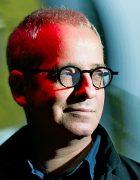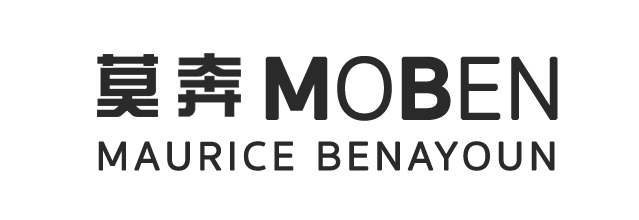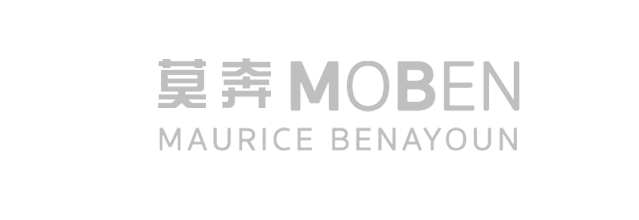Maurice Benayoun (aka MoBen or 莫奔) (born 29 March 1957 in Mascara, Algeria) is a French pioneer, contemporary new-media artist, curator and theorist based in Paris and Hong Kong. His work employs various media, including (and often combining) video, computer graphics, immersive virtual reality, the Internet, performance, EEG, 3D Printing, large-scale urban media art installations, and interactive exhibitions. Often conceptual, Maurice Benayoun’s work constitutes a critical investigation of the mutations in contemporary society induced by the emerging or recently adopted technologies.

MAURICE BENAYOUN 莫奔
New Media Artist, Theorist and Curator
MoBen in a nutshell
He invented the 3D CGI series when we were still watching Sesame Street[1]. He dug a tunnel in VR under the Atlantic when we were discovering the World Wide Web. [2] He started the first contemporary art collection in Virtual Reality, when many expected colorful canvases and white marble. [3] He combined VR and AI as a medium when we wanted oil painting [4]. He organized a photo safari in the Land of War[5] to erase the traces of dark memories. He created the first networked exhibition when most of us started neglecting museums[6]. He created 20 fragrances to put the Essence of Contemporary Art into bottles[7] and tried to make music with a dildo[8]. He converted the world’s emotions into musical cocktails[9] and then into luxury products[10]. He transformed the Arc de Triomphe into a monument to Peace[11], Shanghai into QR codes[12], and the façade of the Hong Kong highest tower into a university campus and a public art space[13]. He invited New Yorkers to occupy wall screens[14]. After turning the weather data into the World’s emotion forecast[15], he compared citizens’ emotions to financial stock on a trader’s building façade[16]. He dropped his unfinished projects into a blog[17] that he later defended in la Sorbonne as a doctoral thesis[18].
He presently converts human thoughts into objects[19] and Human Values into tradable tokens[20]. Together with Refik Anadol, he installed two “immigrant” artworks in Barcelona’s streets, attempting to understand the locals and each other[21], and gave two robotic arms the ability to play chess in a futile attempt to comprehend human conflicts[22].
[1] Quarxs, (Paris, 1991-93) [2] Tunnel under the Atlantic, (Centre Pompidou-MAC Montreal,1995) [3] Art After Museum, (Paris, 1992) [4] Is the Devil Curved? (Mont Carlo, 1995) [5] World Skin, a Photo Safari in the Land of War, (Linz, 1997) [6] The Navigation Room, New Image, New Networks, (Paris, 1997) [7] White Cube, l’Essence de l’Art Contemporain, (Paris, 2010) [8] Dildomatic Opera (Paris, 2010) [9] Emotion Vending Machine, (Berlin, 2006) [10] Emotion Market, (Shanghai, 2005) [11] Between War and Peace, (Paris, 2008-19)[12] NeORIZON, (Shanghai, 2008) [13] Open Sky Project, (Hong Kong, 2014 -2016) [14] Occupy Wall Screens (New York City, 2012)[15] Emotion Forecast, (Paris, NYC… 2011) [16] E-SCAPE TODAY! (Seoul, 2012) [17] The Dump, (Paris, 2006-2008) [18] Artistic Intentions at Work, Hypothesis for Committing Art, (Paris, 2008-2011), [19] The Brain Factory, (Hong Kong, Seoul, Brisbane… 2016), [20] Value of Values, Transactional Art on the Blockchain, (HK, Seoul, Taipei… 2019). [21] DïaloG (HK, Barcelona 2021-2022). [22] Power Chess (HK, Cannes, Berlin, Seoul, Shenzhen, 2021 – 2023)
Biography (from en.wikipedia.org)
Born in Mascara, Algeria, in March 1957, from a father killed before his birth in the Algerian independence war. He moved to France in 1958, following his mother and brother, to live in the popular suburbs of northern Paris, where the family stayed for most of his childhood.
Video art and computer graphics
Taught in Contemporary and Fine Arts, Benayoun’s practice rapidly moves to photography, video, and computer graphics. In the 80s, Benayoun directed video installations and short videos about contemporary artists, including Daniel Buren (1983), Jean Tinguely, Sol LeWitt, and Martial Raysse (1985). He kept from his Fine Arts background a critical and conceptual approach to practice. In 1987, he co-founded Z-A Production (1987-2003), an innovative computer graphics and Virtual Reality private lab, that became one of the leading companies in France in the field during this pioneering time. This is where he started exploring the potential of the most advanced media. Between 1990 and 1993, Benayoun collaborated with Belgian graphic novelist François Schuiten on Quarxs, the first animation series created using HD computer graphics, which explored variant creatures with alternate physical laws. From the pilot (1991) to the series broadcast in prime time in 1993, Quarxs received numerous international awards.
Interactive Art, Virtual and Augmented Reality
In 1993, he received the Villa Medicis Hors Les Murs award for his Art After Museum project, a virtual reality contemporary art collection. After 1994 Benayoun was involved with more virtual-reality and interactive-art installations. One important work from this period includes The Tunnel under the Atlantic, completed in 1995. For his first solo show, Maurice Benayoun presented a Virtual Reality installation linking two prominent museums: the Pompidou Center in Paris and the Museum of Contemporary Art in Montreal. More than a technical performance, that it was too as the first intercontinental virtual reality artwork (called “televirtuality”, Philippe Quéau, 1994), this installation was one-of-a-kind example of what Maurice Benayoun calls architecture of communication, another way to explore the limits of communication presaging the rise of the phatic in human communication.
World Skin, a Photo Safari in the Land of War, created in collaboration with composer Jean-Baptiste Barrière, is an immersive installation often presented as a reference in virtual art. One of the first virtual reality works with a specific content: the relationship between war, personal engagement, and memory, World Skin was awarded the Golden Nica at Ars Electronica 1998, the primary distinction in interactive arts.
Interactive exhibition design
The Navigation Room (1997, exhibition New Image, New Networks) and The Membrane (2001) were created for the Cité des Sciences et de l’Industrie in Paris. The Navigation Room can be considered the prototype of an interactive educational exhibition, offering a deeply immersive experience with highly personalized visits and content, generating a web page dedicated to each visitor. The Membrane (2001) — the core of the exhibition “Man Transformed” — was a large surface that breathed and felt the presence of visitors, digesting and distributing information in constant physical dialogue with the public. Benayoun defined this as organic design. The Panoramic Tables for the Planet of Visions pavilion at Hanover EXPO 2000, directed by François Schuiten, was an innovative application of augmented reality. In 2006, with architect Christophe Girault, they created War and Peace, a permanent exhibition inside the Arc de Triomphe in Paris, which opened in February 2007. War and Peace questioned the significance of a national monument dedicated to Napoleon’s Army. The exhibition was destroyed in fall 2018, during the Yellow Vest movement in Paris. After Art Impact (Pompidou Center, Paris, 2000) where he used for the first time VR binoculars to share the experience of watching (the Collective Retinal Memory) Benayoun conceived and directed the exhibition Cosmopolis, Overwriting the City (2005), a large scale art and science immersive installation presented during the French Year in China in Shanghai, Beijing, Chengdu, and Chongqing. This immersive exhibition received in Shanghai up to more than ten thousand visitors per day. This was Maurice Benayoun’s first experience in China, and the reception by the public played an important role in Benayoun’s later move to Asia. Benayoun initiated the series of works, Mechanics of Emotions, in 2005, which presents the Internet as the world’s nervous system and world emotions as a possible material for a new metaphoric model of the economy. In this series, Benayoun produced many installations and urban art projects during the 10 years that followed.
Urban Media Art
Benayoun began working on urban media in 2002, with Watch Out! in Seoul, an urban installation about surveillance commissioned by the Art Center Nabi. In 2008, he exhibited NeORIZON on the streets of Shanghai, a large-scale urban installation that converts the public into QR codes, which become the building blocks of the city. From the series Mechanics of Emotions, he produced numerous urban screen artworks, including Emotion Forecast (2011, Paris; 2012, New York, São Paulo, Berlin, Melbourne, Hong Kong). To extend his vision of Urban Media Art, Maurice Benayoun launched in 2014, as a curator, the Open Sky Project, inviting artists (the Open Sky Gallery), and MFA students (the Open Sky Campus) to conceive and present works for one of the largest screens in the world at the time, the Hong Kong ICC media façade (70,000 sqm). This program offered more than 100 artists and students the opportunity to exhibit their work in the public space. The ICC media façade represents approximately half of the surface area of the Hong Kong Skyline video displays.
Education, teaching, and lectures
To finance his studies, he became in 1978, a secondary school teacher in fine arts and literature. Benayoun graduated in Fine Arts (Pantheon-Sorbonne University) in the early 1980s, when he was already teaching full time. He was awarded in 1982 with Aggregation d’Arts Plastiques, a highly competitive degree in the French education system leading to a tenure position, opening the doors of University teaching. From 1984 to 2010 he was an assistant professor at Paris 1 University, Pantheon-Sorbonne, where he was co-founder and art director of the CITU research center (Création Interactive Transdisciplinaire Universitaire) together with Paris 8 University. CiTu, dedicated to research and creation (R&C) in the emerging forms of art, is where he developed many National, European and International collaborative Art and Science research programs. In 1995 – 1997, Benayoun was the Invited Artist and Professor at ENSBA, the French National School of Fine Arts. In 2008, Maurice Benayoun submitted his blog, The Dump, a collection of unfinished art projects, as a doctoral thesis entitled “Artistic Intentions at Work: Hypothesis for Committing Art” at Université Paris 1, La Sorbonne. Supervised by Prof. Anne-Marie Duguet, the PhD thesis was awarded “mention très honorable, avec felicitations du jury” (First-Class Honors with Distinction). The defense, presented before an international examination panel and published in 2011, was a performance fully video recorded.
In 2010, Benayoun became an associate professor at Paris 8 University, where he founded (2011) the H2H Lab (the Human to Human Lab), a cluster of public and private labs envisioning art as an advanced form of human mediations. The same year he co-founds Arts-H2H Labex (Lab of Excellence) a research lab lead by Paris 8 University. In August 2012, he became a full Professor in the School of Creative Media of the City University of Hong Kong. He is Chair of the School of Graduate Studies and the PhD program (2014-2018). In 2024, he relocated to Nanjing to serve as a Distinguished Professor and Head of the Art and Architecture Intelligence Lab.
Maurice Benayoun gave over 400 invited and Keynote lectures at major universities and international conferences. This includes Columbia University, Cornell, Duke, UCLA, UCSD, UCSB, SFAI, Parsons School of Design, University of Toronto, UCL, Goldsmiths, Ecole Polytechnique, ENS Ulm, Keio University, Central Academy of Fine Arts, Tsinghua University, to name but a few.
Awards
-
- Chevalier of Arts and Literature (knighthood), by the French Ministry of Culture, 2000
- “Maurice Benayoun collection” in the collections of the INA (National Audiovisual Institute), the CNC (Centre National du Cinéma), and the BNF (Bibliothèque Nationale de France), 2014
- Golden Nica, Interactive Art category, Ars Electronica, June 1998.
- Villa Medicis Hors les Murs Award, from the French Foreign Office, 1992
- Pioneer of e-Culture Awards, 3rd edition, Latino-America Europa 2023 (official May 4, 2023)
- Guest Artist of Honor, OPLINEPRIZE 2022-23
- HAB (Hong Kong Home Affairs Bureau) 10th-round funding exercise of the Arts Capacity Development Funding Scheme, submitted by Osage Art Foundation, Project: HKACT! ACTS 11-13, Feb 2021 – Oct 2022
- Feature Artist, “The Articulated Space, Artists Database of Spatiality and Temporality.” Arte en construccion, Gruppo de innovacion docente, 2021, https:// www.um.es/aec/?page_id=751
- Feature Artist, Thuc, Caroline Ha. “Maurice Benayoun – Studio.” Hong Kong’s Art Magazine – Artomity no. No.21, 2021. , Hong Kong’s Art Magazine, 2021.
- Research Project on Robotics and Sound: ROBOT CHECK, Commissioned by Foca-Naim, Feb 2021.
- Feature Artist, “Hyundai – Blomberg prestigious Art +Technology program”, Blomberg Media, Culture & Entertainment. YouTube, October 11, 2020. , Blomberg Media, 2021.
- ACIM Research Fellowship, 2 years, Bridging the Real and the Virtual, Oct. 2020. (found @ Research Grant)
- Prix de la critique d’Art, AICA France 2019, Finalist, critique by Jean-Jacques Gay,
- Feature Artist. ADA Archive of Digital Art. Database of virtual art. I 2019. https://www.digitalartarchive.at/database/artists/general/artist/benayoun.html
- Novum Design Awards, Golden Interior Design Award, 2019
- World Omosiroi Awards, Finalist, Osaka Knowledge Capital, Japan, 2019
- S+T+Arts HORIZON2020, The Arts Stimulating Innovation, highly competitive collaborative EU grant, awarded in Aug. 2018
- ACIM Research Fellowship, 2018, 3 years: Challenges and Opportunities of Blockchain Technology for Hong Kong’s Cultural and Creative Industries.
- Selection, shortlist, competition “Réinventer Paris”, with Atelier CMYT, March 2018
- OPLINE PRIZE, finalist, 2017
- ACIM Research Fellowship, 2017, 3 years, Reverse Neuro-Design
- Prix Ars Electronica Visionary Pioneer of Media Art (nomination), 2014
- Absolut Think Tank Award, Athens, June 2012
- SACD Award, Interactive Arts, Paris, June 2009
- Qwartz, digital art, Paris, April 2009
- e-Toile d’Or, Net Art, Paris, January 2005
- Best multimedia project, Grotte Chauvet, France 2001
- Winner, Architecture competition with Jean Nouvel, Subway Station Franklin Roosevelt, Paris 2000
- Golden Nica (first prize), interactive art category, Ars Electronica Festival, Linz, Austria, 1998
- Second prize, Images du Futur ’96, category opens titles, Montreal 1996
- Second prize, Pixel INA, Open Titles Category, Imagina 1996, Monte Carlo, February 1996
- Finalist Best Achievement, International Monitor Awards, Opens/closes category, Los Angeles, Oct. 1995.
- Honorary Mention, Ars Electronica Festival, Linz, Austria, April 1995
- JOSE ABEL Prize, Best European animation film, Cinanima, Animation Film Festival of Espinho, Portugal, Oct. 1994
- Silver Trophy, Espace Creation, F.A.U.S.T., Toulouse, Novembre 1994
- Distinction (2nd prize), Ars Electronica Festival, Linz, Austria, June 1994
- 3rd Prize, fiction category, Imagina ’94, Monte Carlo, February 1994
- Best Electronic Special Effects, International Monitor Awards, Los Angeles, 1993
- Best Video Paint Design, International Monitor Award, Los Angeles 1993
- Nomination, Best Computer Animation, International Monitor Awards, Los Angeles 93
- First Prize Pixel INA, Open Title category, Imagina ’93, Monte Carlo, February 1993
- 3rd Prize, FICTION category Imagina ’94, Monte Carlo, February 1993
- First Prize, Third Dimension Award, SCAM, Paris, November 1991
- Best Script Award, Paris Cité 1991, Paris, October 1991
- Honorary Mention, Ars Electronica Festival, Linz, Austria, September 1991
- 1st Prize, Artistic Animation category, Truevision competition, SIGGRAPH, Las Vegas, 1991
- Image fixe prize, Paris Cité, Paris, France, 1990
- 1st Prize Communication Image, Tech Image competition, Paris, 1990
Selected works
- 935m de Bandes, Buren, (video triptych, 1983)
- Pièces à convictions, Bertrand Lavier, Jean-Luc Vilmouth, Jean Le Gac, Jean Tinguely, Takis, Jean-Michel Alberola, Martial Raysse, Bill Woodrow, (8 video, 1985)
- Quarxs (3D CGI series 1991-1993)
- Big Questions: Is God Flat? (1994)
- Is the Devil Curved? (VR installation, 1995)
- And what about me? (Internet participative works, 1996-7)
- World Skin, a photo safari in the Land of War (1997)-Golden Nica, Ars Electronica Festival 1998
- Crossing Talks, Communication Rafting (Virtual Reality Internet installation, 1999)
- Art Impact, collective Retinal Memory (interactive installation, 2000)
- Labylogue (televirtual interactive installation, 2000)
- So.So.So.., Somebody, Somewhere, Some Time (interactive installation, 2002)
- Watch Out (urban installation, 2004)
- Cosmopolis, Overwritting the City (Large-scale interactive installation, 2005)
- Mechanics of Emotions (series of works, 2005- )
- NeORIZON (urban interactive installation, 2008)
- Still Moving (interactive sculpture, 2008)
- The Dump (blog, 2006-2008 )
- Last Life (online game, 2010)
- Emotion Forecast (Internet, urban screens, 2010)
- Dildomatic opera (music instrument, 2011)
- White Cube, L’Esprit de l’Art Contemporain (perfume, 2011)
- Sans Armes Citoyens (Internet collaborative work, 2011)
- Occupy Wall Screens (Urban screen, Internet real-time video, 2012)
- Osmotic World (Interactive installation, exhibition, Athens, 2012)
- Tunnels around the World (Telematic installation, Seoul, San Jose, Hong Kong, Montreal 2012)
- E-SCAPE TODAY! (Urban screen, Internet, Seoul Square, Seoul, 2012)
- Emotion Winds (Urban screen, Internet, Media Fest, Mumbai, 2014)
- Colors Tunnel (VR, Internet, video, Osage Gallery, HK, 2016)
- Borders Tunnel (VR, Internet, video, Osage Gallery, HK, 2016)
- Brain Factory Prototype (EEG, VR, 3D Printing, Art Center Nabi, Seoul, South Korea, 2016)
- HK Escape Views, (360 video + VR 2021)
- Value of values, Speculative Speculations on Art and Values (EEG, Trading Platform, NFTs, 2019-…)
- Periodic Table of Values, interactive media, 2022
- Conceptual Map, 2022
- AI Think Therefore AI Am, (GenAI, animation, 2024)
Bibliography
- Maurice Benayoun, The Dump, 207 Hypotheses for Committing Art, bilingual (English/French) Fyp éditions, France, July 2011, ISBN 978-2-916571-64-5
- Timothy Murray, Derrick de Kerckhove, Oliver Grau, Kristine Stiles, Jean-Baptiste Barrière, Dominique Moulon, Jean-Pierre Balpe, Maurice Benayoun Open Art, Nouvelles éditions Scala, 2011, French version, ISBN 978-2-35988-046-5
- Sara and Tom Pendergast, Contemporary Artists, St James Press, 2001, pp. 155–158, ISBN 1-55862-407-4
- Peter Weibel, Jeffrey Shaw, Future Cinema, MIT Press 2003, pp. 472,572-581, ISBN 0-262-69286-4
- Oliver Grau, Virtual Art, from Illusion to Immersion, MIT Press 2004, pp. 237–240, ISBN 0-262-57223-0,
- Frank Popper, From Technology to Virtual Art, MIT Press 2005, pp. 201–205, ISBN 0-262-16230-X
- Derrick de Kerckhove, The Architecture of Intelligence, Birkhäuser 2005, pp. 40,48,51,73, ISBN 3-7643-6451-3
- Gerfried Stocker and Christine Schöpf, Flesh Factor, Ars Electronica Festival 1997, Verlag Springer 1997, pp. 312–315
- Fred Forest Art et Internet, Editions Cercle D’Art / Imaginaire Mode d’Emploi, pp. 61 – 63
- Christine Buci-Glucksmann, “L’art à l’époque virtuel”, in Frontières esthétiques de l’art, Arts 8, Paris: L’Harmattan, 2004
- Dominique Moulon Moulon.net, Conférence Report: Media Art in France, Un Point d’Actu, L’Art Numerique, p. 123
- Barbara Robertson, CGW.com, Without Bounds in CGW volume 32 issue 4 April 2009
- Dominique Moulon, Art Contemporain, Nouveaux Médias, Nouvelles éditions Scala, Paris 2011, ISBN 978-2-35988-038-0
- Paul Catanese, Director’s Third Dimension: Fundamentals of 3d Programming in Director 8.5, Sams Publishing, 2001, p. 314. ISBN 0-672-32228-5
- Stephen Wilson, Information Arts: Intersections of Art, Science, and Technology, MIT Press, 2002, p. 705. ISBN 0-262-73158-4
- Lars Qvortrupp, Virtual Space: Spatiality in Virtual Inhabited 3d Worlds, Springer, 2002, p. 222. ISBN 1-85233-516-5



